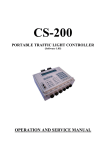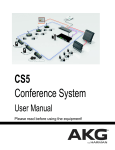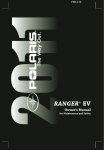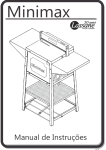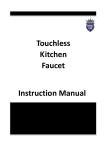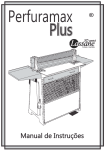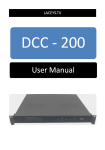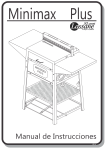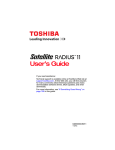Download OPERATION AND SERVICE MANUAL - Lincast International Pty Ltd
Transcript
CS-TRH3 RADIO REMOTE CONTROLLER (Software 1.04) OPERATION AND SERVICE MANUAL CS-TRH3 Service Manual Page 2 Manufactured by: LINCAST INTERNATIONAL PTY. LTD. 2/3 SIR LAURENCE DRIVE SEAFORD, VICTORIA 3198 PH: (613) 776-4442 FAX: (613) 776-4443 __________________________________________________________________________________________ Lincast International Pty. Ltd. Ref: 04 Doc-04 19/7/13 CS-TRH3 Service Manual Page 3 TABLE OF CONTENTS CS-TRH3 RADIO MANUAL CONTROLLER SPECIFICATIONS .................................................................... 4 FEATURES .................................................................... 5 OPERATION .................................................................... 6 TECHNICAL DESCRIPTION .................................................................... 8 - Interconnect - Power - Micro processor - Control - Display - System address - Data TX/RX MAINTENANCE ................................................................... 10 - Dismantle - Adjustments CHARGING - CS-TRH3 240V AC Charge ……………………………………………11 - CS-TRH3 12V DC Vehicle Charge………………………………………….12 - CS-TRH3 External Power only………………………………………………13 __________________________________________________________________________________________ Lincast International Pty. Ltd. Ref: 04 Doc-04 19/7/13 CS-TRH3 Service Manual Page 4 SPECIFICATIONS Electrical External Power Supply Voltage Current Consumption (11v) 10v - 18v 80mA 700mA Temperature -15 deg to 60 deg C. Dimensions Length Width Height Weight 1150 gm. (Rx) (Tx) 250mm 100mm 65mm Operational Specifications Activity Time Out Operating Time on Internal Battery Battery Charge Time Distance from Master Unit 5 minutes Approx 8 Hours (Depending on use) Approx 1 Hour 1000m (LOS) Transmitter Power Output Carrier Freq Deviation Modulation Data Format VF Freq. 0.9 watt 151.4MHz (or as specified) 3.0KHZ FM V23 Standard 1.3 Khz 2.1 Khz __________________________________________________________________________________________ Lincast International Pty. Ltd. Ref: 04 Doc-04 19/7/13 CS-TRH3 Service Manual Page 5 OPERATIONAL FEATURES * Water-resistant * Rugged housing and construction. * Automatic turn on and turn off. * LCD displays * Any number of remotes may be used with a single system. * Can be used with all Manual Modes. * 8 Hour operation on Internal Battery. * Serial No. of the System it is to control must be programmed into the Remote Controller by the Master before it can become operational. * Programmed serial number held in EEPROM (No backup battery required) * External power connection and indication on top panel. * Fast charger available. - Current Lantern Conditions - Current Mode of Operation - Any Fault Conditions - Low Battery - Serial No. and Software Version - Receive and Transmission information - Out of Range Warning __________________________________________________________________________________________ Lincast International Pty. Ltd. Ref: 04 Doc-04 19/7/13 CS-TRH3 Service Manual Page 6 OPERATION Turn On To turn on the remote controller, momentarily press any button on the controller. The LCD display will read "CS-200 : V1.03" and then display the condition of the system or "REMOTE NOT RECEIVING". If "Remote Not Receiving" is displayed, the probable cause will be that the serial number of the system needs to be programmed into the controller. (See Programming) The first operation of any button is used to turn the unit ON. The second operation is transmitted as per normal. Turn Off The remote controller has been designed to turn itself OFF 5 minutes after the last button was pressed. The serial number of the system is automatically stored in memory so programming is only required to be done once for any particular system. If the unit is running on external power the Controller will remain ON until the power is removed. Programming When the remote controller is turned on and the LCD displays "REMOTE NOT RECEIVING", the probable cause will be that it requires to be programmed with the serial number of the system it is to control. The procedure to do this is as follows :1. Turn on the CS-200 Traffic Light Controller and select "FLASH YELLOW" on the MASTER 2. While holding down the "RETURN" on the remote controller, key in the following code on the MASTER key pad :600 "YELLOW TIME" The display on the remote controller will indicate that it is being programmed and show the serial number of the system. Stop Button When the system is in "MANUAL 1" and the STOP button is pressed, both the Master and Slave will go to RED. If the system is in "FLASH YELLOW", "AUTO" OR "NORMAL", "MANUAL 1" is automatically selected with the Master and Slave showing RED. The MASTER GREEN and SLAVE GREEN buttons are now operational and it will operate the same as the cable manual controller. __________________________________________________________________________________________ Lincast International Pty. Ltd. Ref: 04 Doc-04 19/7/13 CS-TRH3 Service Manual Page 7 Return Button This button has two functions :1. Used for programming the remote. (See Programming) 2. Returning the system back to the previous mode of operation. eg:Assume the system is in "NORMAL" mode. The STOP button on the remote controller is pressed and the system goes to "MANUAL 1". After controlling the system in "MANUAL" mode, and you wish to return to the "NORMAL" mode, press the RETURN button. The system automatically selects "NORMAL" and continues on without any disturbance to traffic flow. This feature only works when the system is in ONE WAY OPERATION and the previous mode was either "NORMAL" or AUTO" modes. (Cannot go back to "FLASH YELLOW") Operational Requirements * The controller should be operated while the unit is held in the hand and preferably in line of sight of the Master Control Unit. Control range is up to 1Km, depending on conditions. The controller may be used from vehicles but the range of control will be reduced. * KEEP OUT OF DIRECT SUNLIGHT. Should this happen for an extended period, the display will go black and render itself unreadable. It will usually recover when the controller cools down but it cannot be guaranteed. * Unit should only be recharged with the Battery Charger provided. LCD Display Screens "CS-200 : V1.03" Is displayed on initial turn on and indicates the software version. "Remote not receiving" Indicates the Master controller is turned off or that the serial number of the system has not been programmed into the controller. "Prog SN xxx" Indicates that the serial number of the system is being programmed into the controller. " (MODE) " Indicates the mode in which the system is currently running. "Wait - Timing" Indicates that a button on the controller has been pressed but the system is waiting for a "minimum time" to expire before the function can be implemented. __________________________________________________________________________________________ Lincast International Pty. Ltd. Ref: 04 Doc-04 19/7/13 CS-TRH3 Service Manual Page 8 TECHNICAL DESCRIPTION Interconnect All components are mounted on one Motherboard which runs the length of the case. The LED provides indication that external power is present. Power Internal power is provided by a 700mA / 10.8V battery situated in the base of the controller. When any button is pressed, (eg - S3) the base of Q9 is grounded via D5, R10. Q9, Q5 both turn on, supplying power to the IC regulators IC9, IC10. IC10 provides 5V to the PCB and IC1 is reset by the pulse applied to IC1-9 by C3. S3 also grounds IC1-13 (INT 1) via D1 which initiates the program. IC3-6 goes high, turning Q6 on via R9. Q6 collector holds the base of Q9 low via R25, thus holding power on. After 5 minutes of no button activity, IC3-6 goes low and turns Q6 OFF. Q9 turns OFF which removes power to the IC regulators. External power is applied directly to the IC regulators via protection diode D2. The battery is tricklecharged via D4, R34 while external power is applied. IC9 is an adjustable regulator which supplies the transceiver only and is adjusted so that the transmitter gives out .9 of a watt. Voltage Sensing The voltage which is applied to the input of the regulators is also applied to the voltage sensing circuit via R5. The voltage divider R6, RV1, R7 provides a voltage at IC6-3 which is compared with an internal reference. If the voltage on IC6-3 goes below that reference, IC6-4 goes low and a LOW BATTERY indication is given. Micro processor IC1 is a micro processor complete with 256 of RAM and 16K of ROM. Also it has its own internal oscillator and UART. Port 1 is a multiplexed Address/Data bus but is used only to send and receive data from IC3 & IC4. IC2 is an address decoder which selects IC3 or IC4. IC8 is an EEPROM which stores the system address. It is selected by IC3-9 and clocked by IC3-12. Data to and from IC8 is provided by IC1-1 & IC1-2. Control IC4 is a tri-state buffer which is enabled when a button operation has been sensed by IC1. D9 to D12 are to prevent the 10.8 volts from the battery being applied to the IC4 inputs via Q5, Q9, R10 & D5 to D8. Assume the STOP button (S4) is pressed. IC1-13 is held LOW via D6, D1 which initiates the selecting of IC4. IC4-4 is held low via D11 which is applied to the data bus, read by IC1 and the appropriate action occurs. __________________________________________________________________________________________ Lincast International Pty. Ltd. Ref: 04 Doc-04 19/7/13 CS-TRH3 Service Manual Page 9 Display The display is updated only when a change occurs. Data comes directly from IC1 port 1 while enable, selection and read/write are via IC3. (Selection refers to either line 1 or line 2.) Brightness is controlled by the voltage divider R42 and R44. The display , if left in direct sunlight for extended periods, will go black and be virtually unreadable. When it has cooled down it will usually recover but it cannot be guaranteed. System Address The system address is received from the MASTER via the communication system. The following procedure must be performed before the remote will store the address which is as follows :* The RETURN button on the remote is held down. While the remote is in this condition, it must receive a data transmission with the PROGRAM bit set before it will store the address of that transmission in EEPROM. From that transmission on, the REMOTE will operate normally. * To set the PROGRAM bit in the data transmission the following is entered into the MASTER :600 "YELLOW TIME" On the next transmission to the REMOTE, the MASTER sets the PROGRAM bit. This occurs for ONE transmission only and the above key sequence needs to be entered in each time you require to program a REMOTE. Note:- Any number of REMOTES may be programmed and used with a system. Transmission IC5 is an FSK MODEM which uses the V23 communication protocol. IC1 produces a serial data stream from it's TXD output, IC1-11, and applies it directly to IC5-14. IC5 is switched to transmit by IC3-16 going low. The O/P of IC5 is fed to the base of Q8 via C13, R14 which is an emitter follower driver and is used to provide a low Z source of data. R8, RV3 is a voltage divider network which sets the deviation level into the transmitter. Received data is fed to IC5-4 via C24, R20, R23 where it is decoded into a digital format and applied to IC1-10. R13, R17 set the carrier detect level while R19, R18 sets the receive data level. __________________________________________________________________________________________ Lincast International Pty. Ltd. Ref: 04 Doc-04 19/7/13 CS-TRH3 Service Manual Page 10 MAINTENANCE Dismantle - Remove the two screw covers and screws on the bottom of the unit. - Place the unit face down on a bench and carefully slide the bottom blue section away from the yellow section just enough to be able to disconnect the battery. After this is done, completely remove the bottom blue section, being careful that the battery does not fall out. - Turn unit over and remove the yellow section by sliding it down the steel runners. - To remove the LCD, straighten the wire securing the bottom of the display and remove it by pulling it directly up. Note :- The display must be connected for the unit to work. Adjustments Deviation Connect an RF deviation meter to the antenna connector of the CS-TRH3A and key in the following codes into the master unit:614 "YELLOW TIME" 611 "YELLOW TIME" This will put the CS-TRH3 controller into continuos transmit for 15 seconds. Adjust RV3 for 3.0KHz deviation. Low Voltage Indication Connect an external power source to the unit and adjust it to supply exactly 9.8 volts on TP1 . Turn RV1 FCW. Adjust VR1 anti clockwise very slowly so the LOW BATTERY indication occurs. (Approx 1 sec delay before display occurs.) Tx Power Out when used with a CS-100 controller. Connect an RF power meter to the antenna connector and key the transmitter on continuously by grounding PIN 5 or 6 on CON3. Adjust RV2 for an output power of .9 watt. Tx Power Out when used with a CS-200 controller Connect an RF power meter to the antenna connector and key in the following codes into the master unit:614 "YELLOW TIME" 611 "YELLOW TIME" This will put the CS-TRH3 controller into continuous transmit for 15 seconds. Adjust RV2 for an output power of .9 watt. __________________________________________________________________________________________ Lincast International Pty. Ltd. Ref: 04 Doc-04 19/7/13 CS-TRH3 Service Manual Page 11 Appendix Customer Service Information Warranty Lincast International warrants that this product which it manufactures will be free from defects in materials and workmanship for a period of one year from the date of shipment to the original purchaser. If this product should prove defective during this warranty period, Lincast International will repair the defective product without charge for materials or labour. To obtain warranty service, the customer must notify Lincast International of the defect before the warranty period expires and make arrangements for servicing. The customer will be responsible for packing, shipping and any customs duties or charges required shipping the product to a designated service centre. Lincast International will pay for return shipping of the product to the customer. The customer will be responsible for any customs duties or charges levied on return entry of the product. This warranty will not apply to any defect, failure or damage caused by improper use or improper or inadequate maintenance or care. Lincast International will not be obligated to provide any service under this warranty in the following circumstances: 1. If a defect to this product resulted from repair attempts by personnel other than Lincast International representatives. 2. If a defect has occurred as a result of improper use or connection to incompatible equipment. 3. If a defect occurs where the product has been modified. Lincast International gives this warranty with respect to this product in lieu of any other warranties, express or implied. Lincast International and its vendors disclaim any implied warranties of merchant ability or fitness for a particular purpose. Lincast International and its vendors will not be liable for any indirect, special, incidental or consequential damages irrespective of whether Lincast International or the vendor has advance notice of the possibility of such damages. To arrange warranty service please contact: Lincast International Pty. Ltd. 2/3 Sir Laurence Drive Seaford, 3198 Victoria, Australia. Phone: 03 9776 4442 Fax: 03 9776 4443 Email [email protected] International 613 9776 4442 International 613 9776 4443 __________________________________________________________________________________________ Lincast International Pty. Ltd. Ref: 04 Doc-04 19/7/13 CS-TRH3 Service Manual Page 12 CS-TRH3 Battery Charging from 12V DC Vehicle Plug the cigarette lighter lead provided with the CS-TRH3 into the vehicle while the other end is connected into the input of the battery charger. Connect the lead from the battery charger to the CHARGE input of the CS-TRH3 controller. The indicator on the end of the battery charger will turn RED indicating that the battery is being fast charged. When the battery inside the CS-TRH3 controller is fully charged the indicator on the end of the battery charger will turn GREEN indicating that the battery is now being trickle charged. For best long term performance the battery should not be left on trickle charge for more that 48 hours at a time. Note: The cigarette plug has an internal fuse. __________________________________________________________________________________________ Lincast International Pty. Ltd. Ref: 04 Doc-04 19/7/13 CS-TRH3 Service Manual Page 13 CS-TRH3 Battery Charging from 240V AC Plug the power supply into a 240V AC power point. The lead from the power supply is connected into the input of the CS-TRH3 battery charger. Connect the lead from the battery charger to the CHARGE input of the CS-TRH3 controller. The indicator on the battery charger will turn RED indicating that the battery is being fast charged. When the battery inside the CS-TRH3 controller is fully charged the indicator on the battery charger will turn GREEN indicating that the battery is now being trickle charged. For best long term performance the battery should not be left on trickle charge for more that 48 hours at a time. __________________________________________________________________________________________ Lincast International Pty. Ltd. Ref: 04 Doc-04 19/7/13 CS-TRH3 Service Manual Page 14 CS-TRH3 12V External Power Configuration The CS-TRH3 may be powered by the cigarette lighter DC power lead supplied with the unit. The cigarette lighter plug is connected to the vehicle while the other end is plugged into the 12DC IN connector on the top panel of the CS-TRH3 controller. (Make sure the vehicle is 12V) PLEASE NOTE: This is for Power Only. This option will NOT charge TRH3 Radio Remote. __________________________________________________________________________________________ Lincast International Pty. Ltd. Ref: 04 Doc-04 19/7/13














